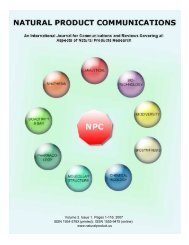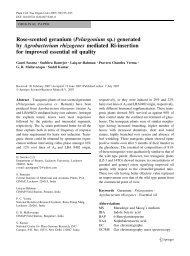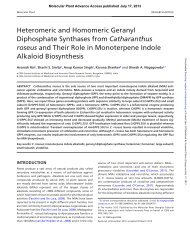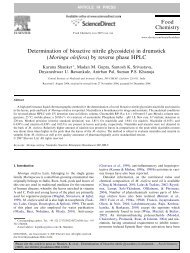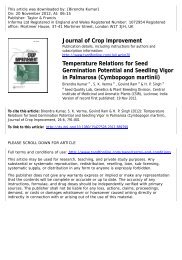Analysis of hairy root culture of Rauvolfia serpentina ... - CIMAP Staff
Analysis of hairy root culture of Rauvolfia serpentina ... - CIMAP Staff
Analysis of hairy root culture of Rauvolfia serpentina ... - CIMAP Staff
You also want an ePaper? Increase the reach of your titles
YUMPU automatically turns print PDFs into web optimized ePapers that Google loves.
<strong>Analysis</strong> <strong>of</strong> <strong>hairy</strong> <strong>root</strong> <strong>culture</strong> <strong>of</strong> <strong>Rauvolfia</strong> <strong>serpentina</strong> ORIGINAL RESEARCH 599Figure 2. DART mass spectrum <strong>of</strong> the <strong>hairy</strong> <strong>root</strong>s <strong>of</strong> Raulvolfia <strong>serpentina</strong>.Table 1. Elemental compositon <strong>of</strong> vomilenine (1) and reserpine (2) in the DART mass spectrum <strong>of</strong><strong>Rauvolfia</strong> <strong>serpentina</strong>Molecular formulaCompound (as M + H) Calculated Measured Error (mmu)1 C 21 H 23 N 2 O 3 351.17086 351.17192 +1.062 C 33 H 41 N 2 O 9 609.28121 609.28368 +2.47a mass difference <strong>of</strong> 0.002 between the measured andthe theoretical m/z value <strong>of</strong> their molecular weights. Theelemental composition for the peaks at m/z 351 and609 were determined using the Mass Center S<strong>of</strong>tware(Table 1). The molecular formula corresponding tothe molecular weight calculated for the two alkaloidsvomilenine and reserpine confirmed their identity. Thedetection and identification <strong>of</strong> reserpine in the <strong>hairy</strong><strong>root</strong>s <strong>of</strong> R. <strong>serpentina</strong> is quite interesting as this is thefirst report <strong>of</strong> expression <strong>of</strong> this important moleculein the <strong>hairy</strong> <strong>root</strong> <strong>culture</strong> <strong>of</strong> this plant. Thus, itappears that DART would be a very useful techniquefor detection and characterization <strong>of</strong> reserpine in the<strong>hairy</strong> <strong>root</strong> <strong>culture</strong>s <strong>of</strong> R. <strong>serpentina</strong> without the use <strong>of</strong>any solvent or sample preparation.CONCLUSIONThe DART mass spectrometric technique has beenapplied for the first time for the pr<strong>of</strong>iling <strong>of</strong> alkaloidsthat were expressed in the <strong>hairy</strong> <strong>root</strong>s <strong>of</strong> <strong>Rauvolfia</strong><strong>serpentina</strong>. It produced an instantaneous response whenthe intact <strong>root</strong>s were placed directly between the DARTsource and the mass spectrometer. Two alkaloids weredetected and they were characterized as vomilenineand reserpine. The results were confirmed by comparingtheir measured molecular formula with the calculatedones. The expression <strong>of</strong> reserpine is quite interesting asit is the first report <strong>of</strong> its occurrence in the <strong>hairy</strong> <strong>root</strong>s<strong>culture</strong>s <strong>of</strong> <strong>Rauvolfia</strong> <strong>serpentina</strong>.AcknowledgmentsGrateful acknowledgement is made to SophisticatedAnalytical Instrument Facility, Central Drug ResearchInstitute, Lucknow, where the mass spectral studieswere carried out. The <strong>CIMAP</strong> communication number<strong>of</strong> this manuscript is 2007-63J.REFERENCESBanerjee S, Madhusudanan KP, Khanuja, SPS and Chattopadhyay, SK.<strong>Analysis</strong> <strong>of</strong> cell <strong>culture</strong>s <strong>of</strong> Taxus wallichaiana using direct analysisin real time (DART) mass spectrometric technique. BiomedicalChromatography 2007 (DOI: 10.1002/bmc.919).Benjamin BD, Roja G and Heble MR. Agrobacterium rhizogens mediatedtransformation <strong>of</strong> <strong>Rauvolfia</strong> <strong>serpentina</strong>: Regeneration and alkaloidsynthesis. Plant Cell, Tissue and Organ Culture 1993; 35: 253–257.Benjamin BD, Roja G and Heble MR. Alkaloid synthesis by <strong>root</strong><strong>culture</strong>s <strong>of</strong> <strong>Rauvolfia</strong> <strong>serpentina</strong> transformed by Agrobacteriumrhizogenes. Phytochemistry 1994; 35: 381–383.Christey MC and Braun RH. Production <strong>of</strong> <strong>hairy</strong> <strong>root</strong> <strong>culture</strong>s andtransgenic plants by Agrobacterium rhizogenes-mediated transformation.Methods in Molecular Biology 2005; 286: 47–60.Cody RB, Laramee JA and Durst HD. Versatile new ion sourcefor the analysis <strong>of</strong> material in open air under ambient condition.Analytical Chemistry 2005; 77: 2297–2302.Guillon S, Tremouillaux-Guiller J, Pati PK, Rideau M and Gantet P.Harnessing the potential <strong>of</strong> <strong>hairy</strong> <strong>root</strong>s: dawn <strong>of</strong> a new era. Trendsin Biotechnology 2006; 24: 403–409.Hooykass PJJ, Klapwijk PM, Nuti PM, Shilpe<strong>root</strong> RA and Rorsch A.Transfer <strong>of</strong> the Agrobacterium tumefaciens Ti-plasmid to a virulentAgrobacteria and Rhizobium explanta. Journal <strong>of</strong> General Microbiology1977; 98: 477–484.Klyushnichenko VE, Yakimov SA, Tuzova TP, Syagailo YV,Kuzovkina IN, Wulfson AN and Miroshnikov AI. Determination<strong>of</strong> indole alkaloids from R. <strong>serpentina</strong> and R. vomitoria by highperformanceliquid chromatography and high-performance thinlayerchromatography. Journal <strong>of</strong> Chromatography A 1995; 704:357–362.Copyright © 2008 John Wiley & Sons, Ltd. Biomed. Chromatogr. 22: 596–600 (2008)DOI: 10.1002/bmc




